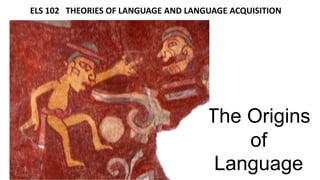
ELS102_English Language and Laguage Acquisition .pptx
- 1. The Origins of Language ELS 102 THEORIES OF LANGUAGE AND LANGUAGE ACQUISITION
- 2. 1. The Divine Source In biblical tradition (God created Adam and Adam Few experiments had been conducted to discover the origin of language. The basic idea of the theory is that: “ If infants were allowed to grow up without hearing any language, then they would spontaneously begin using the original God given language”.
- 3. The Greek historian Herodotus mentioned Psamtik as an example. During his travel to Egypt, Herodotus heard that Psammetichus ("Psamṯik") sought to discover the origin of language by conducting an experiment with two children. Allegedly he gave two newborn babies to a shepherd, with the instructions that no one should speak to them, but that the shepherd should feed and care for them while listening to determine their first words.
- 4. The hypothesis was that the first word would be uttered in the root language of all people. When one of the children cried "βηκοs" (bèkos), the shepherd concluded that the word was Phrygian because that was the sound of the Phrygian word for "bread.” Thus, they concluded that the Phrygians were an older people than the Egyptians, and that Phrygian was the original language of men. The Phrygian language /ˈfrɪdʒiən/ was the Indo-European language of the Phrygians, spoken in Asia Minor during Classical Antiquity (2nd millennium BC to 5th century AD). • King James the Fourth of Scotland carried out the same experiment and discovered thechildren spoke Hebrew. The Divine Source of Language could not be confirmed.
- 5. 2. The Natural Sound Source “ Primitive words could have been imitations of the natural sounds which early men and women heard around them “ Examples: cuckoo, splash, bang, and boom. These words echoing natural sounds are called “onomatopoeic words”. A similar suggestion: “ The original sounds of language came from naturel cries of emotion such as pain, anger and joy. Examples: Ouch! , Ah.... The fact that all modern languages have some words with pronunciation that seems to echo naturally occurring sounds could be used to support this theory. (Bow-wow Theory)
- 6. 3. The Social Interaction Source (Yo-he-ho Theory) The sounds of a person involved in physical effort could be the source of our language, especially when that physical effort involved several people and had to be coordinated. The importance of yo-he-ho theory is that it places the development of human language in some SOCIAL CONTEXT. Early people lived in groups. Groups offered better protection from attack. Groups are social organization. In a group, communication is required. So human sounds were produced.
- 7. 4. The Physical Adaptation Source • This Theory depends on the physical features human posses. Especially those that are distinct from other creatures. Our ancestors made a very significant transition to upright posture, with bipedal, and a revised role for the front limbs. • The theory comes from the idea that there is a link between physical gesture and orally produced sounds. First of all a set of physical gestures was developed as a means of communication. • Then a set of oral gestures specially involving the mouth developed in which the movements of the tongue, lips and so on where recognized according to patterns of movement similar to physical gestures.
- 8. • The focus is on the biological basis of the formation. In the evolutionary development there are certain physical features, best thought of a practical adaptations that appear to be relevant for speech. • Human teeth, lips, mouth, tongue, larynx, pharynx and brain have been created in such a way to coordinate in producing speech sounds. Their places, connections and coordinative functions make humankind different from all the living creatures.
- 9. Teeth=upright, not slanting outwards. Lips= have much intricate muscles. Mouth=small. Tongue=can be used in variety o shapes. Humans can close off the airway through the nose to create air pressure inside the mouth. Larynx=(voice box) different position- upright posture.
- 10. Human body parts have more than one function: Teeth, lips: chewing and sucking producing speech sounds. Human hands: making tools and manual gestures. Brain at work! Human brain is lateralized. It has specialized functions in in each of the two hemispheres. Complex vocalization (Speaking) and object manipulation (making or using tools) are very close to each other in the left hemisphere in the brain. There may be an evolutionary connection between the language using and tool using.
- 11. 5. The Genetic Source The innateness hypothesis is a linguistic theory of language acquisition which holds that at least some knowledge about language exists in humans at birth. This hypothesis supports linguistic nativism and was first proposed by Noam Chomsky. Facts about the complexity of human language systems, the universality of language acquisition, the facility that children demonstrate in acquiring these systems, and the comparative performance of adults in attempting the same task are all commonly invoked in support. A human might have (Language gene) That makes him speak !!